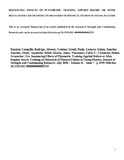Mostrar el registro sencillo del ítem
Sequencing effects of plyometric training applied before or after regular soccer training on measures of physical fitness in young players
| dc.creator | Ramírez Campillo, Rodrigo | es_ES |
| dc.creator | Álvarez, Cristian | es_ES |
| dc.creator | Gentil, Paulo | es_ES |
| dc.creator | Loturco, Irineu | es_ES |
| dc.creator | Izquierdo Redín, Mikel | es_ES |
| dc.date.accessioned | 2021-02-19T08:12:08Z | |
| dc.date.available | 2021-07-01T23:00:14Z | |
| dc.date.issued | 2020 | |
| dc.identifier.issn | 1533-4287 (Electronic) | |
| dc.identifier.uri | https://hdl.handle.net/2454/39265 | |
| dc.description.abstract | To compare the effects of short-term (i.e., 7 weeks) plyometric jump training applied before (PJT-B) or after (PJT-A) soccer practice on components of physical fitness in young soccer players, a single-blind randomized controlled trial was conducted. Postpubertal boys aged 17.0 ± 0.5 years were allocated to 3 groups: PJT-B (n = 12), PJT-A (n = 14), and control (CON; n = 12). The outcome measures included tests to evaluate 20-m speed, standing long jump (SLJ), squat jump (SJ), countermovement jump (CMJ), and drop jump (DJ), 20-m multistage shuttle run endurance (MSSRT), and Illinois change-of-direction speed (ICODT). Although the CON performed soccer-specific training, the PJT-A and PJT-B groups conducted the same soccer-specific sessions but replaced ∼11% of their time with plyometric training. The PJT-B group performed plyometric exercises after a warm-up program, and the PJT-A group conducted plyometric exercises ∼10 minutes after the completion of soccer training. Analyses of variance were used to detect differences between groups in all variables for pretraining and posttraining tests. Main effects of time (all p < 0.01; d = 0.19-0.79) and group × time interactions (all p ≤ 0.05; d = 0.17-0.76) were observed for all examined variables. Post hoc analyses revealed significant increases in the PJT-B group (SLJ: 9.4%, d = 1.7; CMJ: 11.2%, d = 0.75; 20-m MSSRT: 9.0%, d = 0.77) and the PJT-A group (SLJ: 3.1%, d = 0.7; CMJ: 4.9%, d = 0.27; 20-m MSSRT: 9.0%, d = 0.76). Post hoc analyses also revealed significant increases in the PJT-B group (20-m speed: -7.4%, d = 0.75; 20-cm DJ reactive strength index: 19.1%, d = 1.4; SJ: 6.3%, d = 0.44; ICODT results: -4.2%, d = 1.1). In general, our study revealed that plyometric training is effective in improving measures of physical fitness in young male soccer players when combined with regular soccer training. More specifically, larger training-induced effects on physical fitness were registered if plyometric training was conducted before soccer-specific training. | en |
| dc.format.extent | 20 p. | |
| dc.format.mimetype | application/pdf | en |
| dc.language.iso | eng | en |
| dc.publisher | Lippincott, Williams & Wilkins | en |
| dc.publisher | National Strength and Conditioning Association | en |
| dc.relation.ispartof | Journal of Strength and Conditioning Research, 2020, 34(7), 1959-1966 | en |
| dc.rights | © 2020 © 2018 National Strength and Conditioning Association | en |
| dc.subject | Youth soccer | en |
| dc.subject | Physical maturity | en |
| dc.subject | Reactive strength | en |
| dc.subject | Stretch-shortening cycle | en |
| dc.title | Sequencing effects of plyometric training applied before or after regular soccer training on measures of physical fitness in young players | en |
| dc.type | info:eu-repo/semantics/article | en |
| dc.type | Artículo / Artikulua | es |
| dc.contributor.department | Ciencias de la Salud | es_ES |
| dc.contributor.department | Osasun Zientziak | eu |
| dc.rights.accessRights | info:eu-repo/semantics/openAccess | en |
| dc.rights.accessRights | Acceso abierto / Sarbide irekia | es |
| dc.embargo.terms | 2021-07-01 | |
| dc.identifier.doi | 10.1519/JSC.0000000000002525 | |
| dc.relation.publisherversion | https://doi.org/10.1519/JSC.0000000000002525 | |
| dc.type.version | info:eu-repo/semantics/acceptedVersion | en |
| dc.type.version | Versión aceptada / Onetsi den bertsioa | es |


